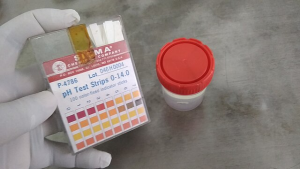63 10.2: Sanitizing
Sanitization
The application of heat or chemicals are used to safely sanitize surfaces, kitchenware and equipment. When used properly, 99.9% or greater of pathogens will be eliminated.
Heat Sanitizing
Heated water or steam can be used to sanitize surfaces, kitchenware and equipment.
Chemical Sanitizing

Chemicals used to sanitize in manual or mechanical systems must comply with EPA approved manufacturers label use instructions and are applied in accordance with the manufacturer’s instructions. The three chemical sanitizers are chlorine, iodine, and quarternary ammonium. Chemical sanitizers must reach the guidelines for concentration and water temperature. Concentration is measured in mg/L or parts per million (ppm) and can be measured using pH test kit.
- Chlorine, commonly referred to as bleach. Items must be exposed to the chlorine sanitizer for a minimum of 10 seconds, at the appropriate concentration and water temperature.
| Minimum Concentration | Minimum Temperature | Minimum Temperature | Exposure Time |
| Mg/L or ppm | >pH 8 – pH 10 | pH 8 or less | In seconds |
| 25-49 ppm | 120°F (49°C) | 120°F (49°C) | 10 sec. |
| 50-99 ppm | 100°F (38°C) | 75°F (24°C) | 10 sec. |
| 100 ppm | 55°F (13°C) | 55°F (13°C) | 10 sec. |
2. Iodine. Items must be exposed to the iodine sanitizer for a minimum of 30 seconds, at the appropriate concentration and water temperature
| Minimum Concentration | Minimum Temperature | Minimum Temperature | Exposure Time |
| Mg/L or ppm | pH of 5.0 or less | >5.0 pH | In seconds |
| 12.5 – 25 ppm | 68°F (20°C) | Follow manufacturer’s guidelines |
|
3. Quarternary Ammonia, commonly referred to as quats. Items must be exposed to the quarternary ammonia sanitizer for a minimum of 30 seconds, at the appropriate concentration and water temperature
| Minimum Concentration | Minimum Temperature | Maximum water hardness | Exposure Time |
| Mg/L or ppm | Follow manufacturer’s guidelines | Mg/L or ppm | In seconds |
| 200 mg/L | 75°F (24°C) | 500 mg/L ppm hardness | 30 sec. |
Food contact surfaces, kitchenware and equipment should be cleaned and sanitized:
- Before each use of a different type of raw animal food
- When changing from working with raw foods to ready to eat foods
- When changing between working with raw fruits or vegetables and time temperature controlled for safety items
- Before and after using a temperature measuring device
- Any time when contamination has occurred
- At minimum, every four hours, while being continuously used.
- At least every 24 hours or when restocking display containers, condiment dispensers, iced tea dispensers and consumer self service utensils (tongs, ladles, serving spoons)
- Per manufacturer’s instructions or build up of soil food or debris for ice machines and bins, beverage dispensers or other closed components of equipment
- At least every 24 hours for cooking or baking equipment, inside and door seals of microwave ovens
A three-compartment sink is necessary for manual washing, rinsing and sanitizing of kitchenware and equipment. The three-compartment sink must be large enough to be able to submerge the largest items such as baking sheets and pots. A drainboard, utensil rack or table is necessary for air drying items and should be self-draining. Ware washing machines, sinks and drainboards should be cleaned before being used and regularly throughout the day as they are being used.
Food establishments that do not have the appropriate mechanical ware washing equipment to clean and sanitize kitchenware and tableware must provide single use disposable items to employees and single service disposable items to consumers.
Food preparation and storage utensils.
milligrams per liter, which is the metric equivalent of parts per million (ppm).
the symbol for the negative logarithm of the hydrogen ion concentration, which is a measure of the degree of acidity or alkalinity of a solution. Values between 0 and 7 indicate acidity and values between 7 and 14 alkalinity. The value for pure distilled water is 7, which is considered neutral.
A surface of equipment or a utensil with which food normally comes into contact or a surface of equipment or utensil from which food may drain, drip, or splash into a food, or onto a surface normally in contact with food.
